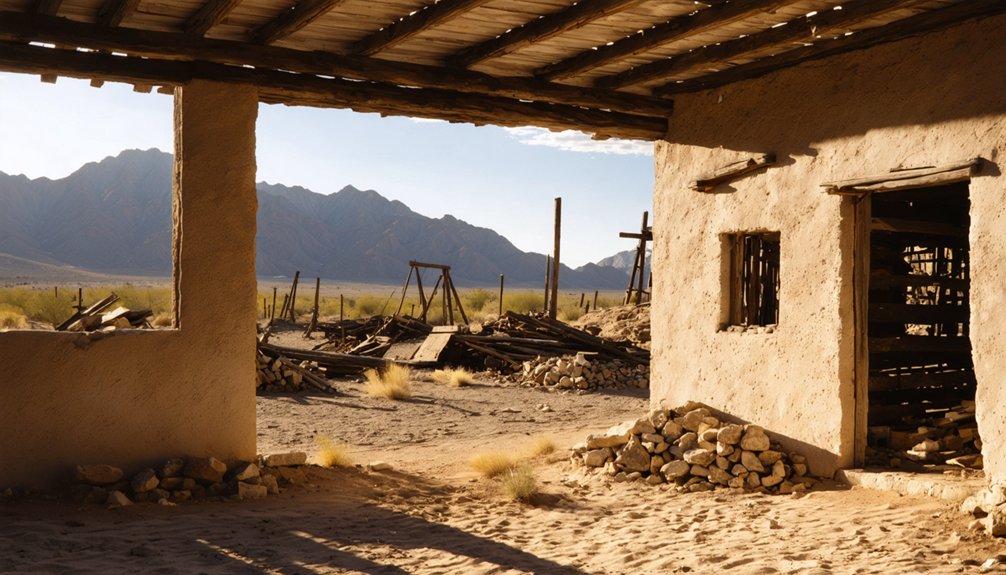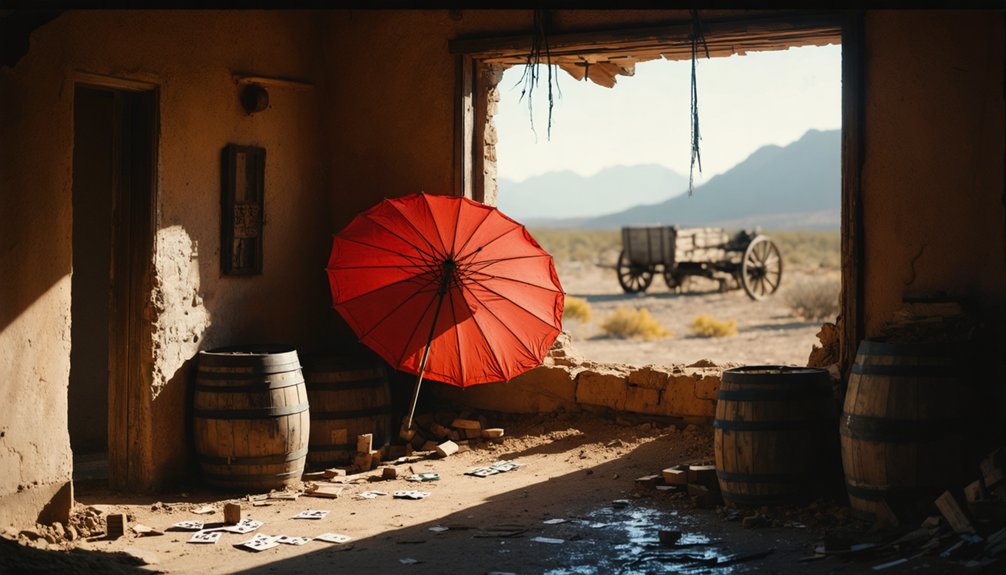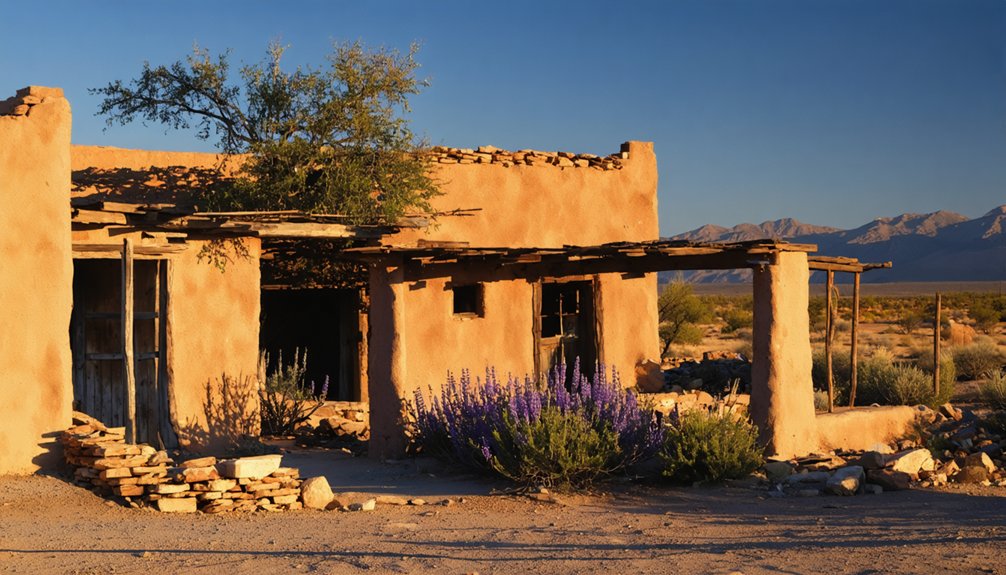You’ll find Pinal City nestled near Queen Creek, a once-thriving silver boomtown that peaked at 2,000 residents in the 1880s. Founded after the Silver King Mine’s 1875 discovery, the town flourished until silver prices collapsed, triggering a dramatic exodus. Today, you can wander among weathered ruins, visit the historic cemetery where Mattie Blaylock rests, and trace deep wagon wheel ruts across the desert landscape. The whispers of Arizona’s mining past await your exploration.
Key Takeaways
- Pinal City was established in 1875 following the Silver King Mine discovery, peaking at 2,000 residents during the silver boom.
- The town rapidly declined after silver prices collapsed in the late 1880s, becoming completely abandoned by 1891.
- Today, visitors can explore the historic cemetery, weathered ruins, and deep wagon wheel ruts from ore transport.
- The ghost town is located near Queen Creek in a landscape featuring mesquites, cottonwoods, and saguaros.
- Mattie Blaylock, a notable figure and former companion of Wyatt Earp, is buried in Pinal City’s cemetery.
Silver Boom: The Birth of Pinal City

While Apache hostility and the Civil War delayed silver development in the Globe area until 1873, the discovery of the Silver King Mine would soon transform this remote corner of Arizona Territory forever.
You can trace this pivotal moment to March 21, 1875, when Mason filed claims after Sullivan’s chance discovery of native silver during military road construction.
The rich vertical silver chimney they uncovered sparked an immediate rush. Miners and investors flocked to this untamed landscape, drawn by rumors of extraordinary silver discoveries.
The silver’s call echoed across territories, drawing fortune seekers to this wilderness of untold riches.
Pinal City sprang up alongside Queen Creek—not at the mine itself—strategically positioned for water access and transportation of ore.
Here, sophisticated mining techniques would soon process the Silver King’s bounty, creating a bustling mill town that lived and breathed with the rhythm of the mine’s operations. At its peak, the boomtown reached a population of approximately 2,000 residents, with all the amenities and challenges typical of western mining settlements.
The mine operated continuously with great success from 1876 to 1887, with production fluctuating alongside silver market prices.
Life in a 19th Century Mining Hub
The rough-hewn streets of Pinal City bustled with a cacophony of languages and cultures as workers from Mexico and beyond converged on this silver boomtown nestled alongside Queen Creek.
You’d witness stark divisions of race and class shaping every aspect of daily life, from the labor hierarchies at the mines to social structures within the community.
Mining labor defined existence here, with shifts rotating day and night at the mills where ore was processed. Ore samples from the Silver King mine were exceptionally rich, with some assaying up to 2,000 dollars per ton.
Apache men integrated into this work while maintaining cultural traditions that connected them to a life beyond the mines.
Women remained largely absent from documented histories, though their presence gradually transformed this male-dominated frontier.
The Southern Pacific’s arrival in 1879 brought newfound connectivity, reducing supply costs and linking your isolated mountain community to the wider world.
Similar to later mining communities like Hayden, economic fluctuations caused significant population changes as mines opened and closed.
The Silver King Mine’s Legacy
Beyond the bustling streets of Pinal City stood the crown jewel that birthed the entire settlement—the Silver King Mine, whose silvery veins transformed this remote corner of Arizona Territory from wilderness to wealth.
You’re witnessing the aftermath of an economic boom that pulled $6.2 million ounces of silver from the earth between 1876 and 1887. The mine’s legacy reaches far beyond its shafts:
- A 600-foot main shaft and extensive underground network that employed countless men seeking fortune
- Technology that evolved from wood-burning to oil-powered operations, marking Arizona’s industrial advancement
- Nearly $2 million paid to investors—money that built fortunes and funded dreams elsewhere
The Silver King was widely acknowledged as the richest silver mine in Arizona during its peak production years. Discovered in the fall of 1874 by prospectors, the mine would go on to shape the region’s economy for decades. Though the Silver King’s lights dimmed permanently in 1920, its impact remains etched in Arizona’s development, transforming isolated wilderness into a connected frontier ripe with possibility.
Queen Creek and the Pinal Mountains: Natural Setting
If you’re standing at Queen Creek today, you’ll see a watercourse that once served the miners of Pinal City, named after the Silver Queen Mine nestled in the rugged Pinal Mountains.
The creek’s intermittent waters carve through an arid landscape of mesquites, cottonwoods, and saguaros, creating a rare ribbon of green against the stark mountainous backdrop.
You can still trace the path early prospectors followed along this essential waterway, where the San Tan Mountains rise to meet a sky that witnessed both the boom and bust of Arizona’s silver dreams. Before acquiring its current name, this waterway was originally known as Picket Post Creek during the early days of settlement in the region. Conservation efforts now focus on removing invasive salt cedar and replacing it with native riparian vegetation to restore the creek’s natural habitat.
Creek’s Mining Role
Originally known as Picket Post Creek after the distinctive mountain towering above it, Queen Creek earned its current name following the establishment of the Silver Queen Mine in the rugged Pinal Mountains.
The creek transformed into a crucial artery for mining logistics, serving as the lifeblood connecting the mineral-rich mountains to the growing settlements below.
You can still trace the paths where:
- Twenty-mule team wagons once hauled Silver King ore along the creek’s winding course
- Miners established Pinal City where the creek provided essential water and transportation
- The Silver Queen’s bounty flowed downstream, carrying the promise of fortune
Queen Creek’s waters whispered stories of boom and bust as they carved through the canyon, its current flowing with the same persistence that drove prospectors to seek their freedom in these untamed hills. The dramatic decline of Pinal City mirrors the broader economic cycles when silver prices plummeted from $1.50 to $0.20 per ounce. Before adopting its current name, the area was temporarily known as Rittenhouse due to the nearby railroad spur established by C. H. Rittenhouse.
Scenic Desert Backdrop
Towering against the azure Arizona sky, the rugged Pinal Mountains create a dramatic backdrop for the historic ghost town of Pinal City, their jagged silhouettes standing sentinel over Queen Creek’s winding path through the Sonoran Desert.
You’ll find yourself surrounded by a landscape shaped by millennia of wind and water, where desert wildlife thrives among unique geological formations.
The once-prosperous Silver Queen Mine area now offers you glimpses of nature’s reclamation, with saguaro forests and desert washes carving through the terrain.
When you explore nearby San Tan Mountain Regional Park, you’ll discover 10,000 acres of preserved wilderness featuring Goldmine Mountain’s panoramic vistas.
During monsoon season, you might witness the transformation as Queen Creek’s normally dry arroyos briefly surge with life-giving waters, a fleeting reminder of nature’s power in this harsh but beautiful environment.
Notable Characters and Colorful Stories

While Pinal City‘s crumbling buildings and weathered artifacts tell much of its story, the characters who once walked its dusty streets breathe life into this long-abandoned settlement.
Perhaps none more tragic than Celia “Mattie” Blaylock, whose final chapter concluded here in 1888. Her laudanum overdose connects Wyatt Earp‘s legacy to these sun-baked ruins, though the famous lawman never lived here himself.
- Frank Doll, founder of nearby Alma and its sole postmaster until 1898, represents the determined frontier leadership that shaped the region.
- Frank Schultz’s gold discovery in what became Tiger exemplifies the prospector’s dream that fueled these settlements.
- The Silver King Mine operators wielded immense power, their decisions determining when Pinal would boom and when it would surrender to the desert.
The Silver Crash and Economic Downfall
As you wander through Pinal City’s ruins today, you’re treading on ground once abandoned during the devastating silver price collapse of the late 1880s.
The Silver King Mine’s closure in 1888 triggered an immediate exodus, with miners and their families departing almost overnight as businesses shuttered and hopes crumbled.
You can almost hear the ghostly echoes of wagon wheels rolling away as the town’s lifeblood—its people—scattered to the winds, leaving behind empty buildings that would soon decay into the haunting remnants you now observe.
Falling Silver Prices
The silver crash of the 1880s struck Pinal City with devastating force, transforming a thriving mining community into an economic wasteland almost overnight.
You’d have witnessed silver price fluctuations that crippled the once-mighty Silver King Mine, which had yielded millions in precious ore during its heyday from 1876 to 1887.
The economic repercussions rippled through every corner of this desert boomtown:
- The shift from silver to gold standard devalued the very mineral that built Pinal City’s fortune.
- Local bank failures dried up capital, leaving millions in untapped ore forever buried.
- Rising operational costs squeezed profits until the mine’s closure in 1888 became inevitable.
Freedom seekers who’d found prosperity in these hills suddenly faced harsh new realities as silver’s value plummeted.
Population Exodus Impact
Following silver’s catastrophic devaluation, Pinal City experienced an exodus so swift and complete that you’d barely recognize the once-thriving settlement.
By 1890, a town that had boasted 2,000 souls just years earlier dwindled to merely ten stubborn holdouts, marking one of the most dramatic economic migrations in Arizona’s mining history.
Community disintegration happened almost overnight. Residents packed whatever they could carry and relocated just miles away to Hastings, which offered promising copper deposits rather than the now-worthless silver.
This mass departure culminated in the post office’s closure in November 1891—the final institutional death knell for Pinal City.
What was once a bustling hub of commerce now sits silent, with only scattered stone foundations and a solitary cemetery telling the story of prosperity’s fleeting nature.
What Remains: Exploring the Ghost Town Today

Ghostly whispers of the past echo across the sunbaked landscape where Pinal City once thrived, though you’ll find precious little remaining of this once-bustling mining community.
Despite housing over 2,000 residents during its peak, the desert has reclaimed most structures.
Three haunting remnants you’ll encounter:
- The historic Pinal Cemetery, final resting place of Mattie Blaylock, Wyatt Earp’s common-law wife, who succumbed to laudanum and alcohol in 1888
- Deep wagon wheel ruts carved into bedrock, evidence of the heavy ore loads transported to service the Silver King mine
- Mysterious holes between the ruts, suggesting targeted extraction activity
West of Superior, you’re free to wander these weathered traces of ambition, where wagon paths and cemetery markers stand as silent sentinels to Arizona’s mining heritage.
Photography Tips for Capturing Pinal City Ruins
As golden light spills across weathered ruins and long shadows stretch over the hardscrabble desert floor, capturing Pinal City’s ethereal remains requires more than just pointing and shooting.
Bring essential photography equipment: a sturdy tripod for stability in dim interiors, a wide-angle lens to embrace the expansive landscape, and a camera with excellent low-light capabilities.
Time your visit during golden hour when the sun casts warm, directional light that enhances textures on crumbling masonry and weathered wood.
Experiment with lighting techniques like natural window illumination for dramatic contrasts or long exposures to capture star-streaked skies above silent structures.
Frame compositions that showcase nature reclaiming human endeavors—vegetation pushing through floorboards or desert sand drifting across thresholds.
Remember to shoot from varied perspectives, getting low to make ruins loom dramatically against Arizona’s boundless sky.
Planning Your Visit to Arizona’s Silver Ghost Town

While capturing the perfect image preserves your ghost town adventure, successfully venturing to Pinal City demands thoughtful preparation before you ever set foot on its silver-tinged soil.
Nestled near Picket Post Mountain, this remote ghost town rewards only the well-prepared explorer with its historic whispers and weathered wagon ruts.
- Time your journey during fall through spring months, when Arizona’s merciful temperatures make hiking through Pinal’s rugged terrain manageable.
- Pack abundant water, sturdy boots, and a detailed map—the ghost town’s scattered foundations reveal themselves only to those willing to search beyond the obvious.
- Consider accessing the site via the LOST Trail, which connects Superior to the historic grounds, offering interpretive signage that breathes life into the silent remnants.
Frequently Asked Questions
Were Any Paranormal Activities Reported in Pinal City?
Dozens of ghost sightings were documented in Pinal City when Travel Channel crews captured supernatural encounters in 2015. You’ll sense the haunted whispers echoing through abandoned saloons and mining shafts.
What Indigenous Peoples Occupied the Area Before Mining Began?
Before miners arrived, you’d find the Pinal Coyotero Apache and Akimel O’odham (Pima) peoples roaming these rugged mountains, their cultural heritage deeply connected to the free-flowing Gila River and surrounding wilderness.
How Did Extreme Weather Affect Mining Operations?
Like clockwork, you’d witness weather extremes wreaking havoc on those mining operations. Floods swallowed shafts, droughts parched processing facilities, and rising groundwater created constant mining challenges requiring expensive pumps and frequent repairs.
Did Any Famous Western Outlaws Visit Pinal City?
While no famous western outlaws are documented in Pinal City, you’ll find Wyatt Earp’s connection through Mattie Blaylock, who lived and died there—the closest brush with western legends this silver town experienced.
What Caused Mattie Blaylock’s Death in Pinal City?
You’ll find Mattie Blaylock’s death shrouded in mysterious circumstances—a lethal mix of laudanum and alcohol. Historical significance surrounds these death theories: suicide from Wyatt Earp’s abandonment or accidental overdose while managing unbearable pain.
References
- https://azgw.org/pinal/ghosttowns.html
- https://westernmininghistory.com/towns/arizona/pinal/
- https://kids.kiddle.co/Pinal_City
- https://www.phoenixmag.com/wp-content/uploads/2017/01/stelprdb5269665.pdf
- https://www.arizonan.com/ghost-towns/pinal-city/
- https://www.ghosttowns.com/states/az/pinal.html
- https://www.youtube.com/watch?v=WNHPUqTDBOs
- https://www.youtube.com/watch?v=AD8krZuPI9g
- http://superstitionmountaintomkollenborn.blogspot.com/2012/02/silver-king-mine.html
- http://www.apcrp.org/SILVER KING/SILVER_KING_main_111207.htm



